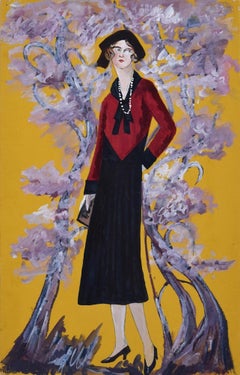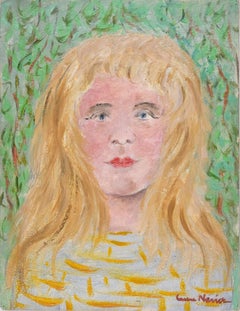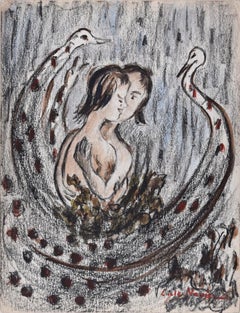Lucie Navier Paintings
to
2
7
4
3
7
Overall Height
to
Overall Width
to
4
5
4
3
2
1
1
1
1
1
1
1
1
1
1
1
7
1
6
8
839
650
649
610
7
5
2
2
2
Artist: Lucie Navier
Poseidon - Ink and Tempera on Paper by Lucie Navier - 1933
By Lucie Navier
Located in Roma, IT
Poseidon is an original painting realized by Lucie Navier in 1933.
Original Ink and tempera painting on paper.
Dated on the lower right corner (23-6-2033).
Fair conditions except...
Category
1930s Modern Lucie Navier Paintings
Materials
Tempera, Watercolor, Ink
Marine - Tempera on Paper by Lucie Navier - 1927
By Lucie Navier
Located in Roma, IT
Marine is a painting realized by Lucie Navier in the 1927.
Tempera on paper.
Mint conditions.
Impressionistic work realized with a Realistic technique and representing a natural...
Category
1920s Modern Lucie Navier Paintings
Materials
Tempera
Madame in the Blossom Garden - Tempera on Paper by Lucie Navier - 1931
By Lucie Navier
Located in Roma, IT
Madame in the blossom garden is an original painting realized by Lucie Navier in the 1931.
Original tempera on paper.
Very good conditions.
Colorful composition representing a f...
Category
1930s Modern Lucie Navier Paintings
Materials
Tempera
Young Blonde Girl - Original Oil on Cardboard by Lucie Navier - 1930s
By Lucie Navier
Located in Roma, IT
Young Blonde Girl is an original painting realized by Lucie Navier in the 1930s.
Original oil painting on cardboard.
Hand-signed by the artist on the lo...
Category
1930s Lucie Navier Paintings
Materials
Oil
Peacocks - Original Mixed Media on Paper by Lucie Navier - 1930s
By Lucie Navier
Located in Roma, IT
Peacocks is a painting realized by Lucie Navier in the 1930s.
Original tempera painting and pastels on cardboard.
Hand-signed by the artist on the lower right corner in red paintin...
Category
1930s Modern Lucie Navier Paintings
Materials
Tempera, Pastel
Muslim - Original Mixed Media on Paper by Lucie Navier - 1930s
By Lucie Navier
Located in Roma, IT
Muslim is an original painting realized by Lucie Navier.
Original tempera painting on paper. The sheet is glued on green cardboard (cm 30.5 x 25).
Very good conditions.
Colorful ...
Category
1930s Lucie Navier Paintings
Materials
Tempera, Watercolor, Ink
In the Woods - Original Oil Painting by Lucie Navier - 1931
By Lucie Navier
Located in Roma, IT
In the Woods is an original painting realized by Lucie Navier in the 1931.
Original oil painting on cardboard.
Hand-signed on the lower right corner.
Very good conditions.
Col...
Category
1930s Lucie Navier Paintings
Materials
Oil, Cardboard
Related Items
"Milton Avery #6"
By Gershon Benjamin
Located in Lambertville, NJ
Gershon Benjamin (1899-1985)
An American Modernist of portraits, landscapes, still lives, and the urban scene, Gershon Benjamin sustained an active career for over seven decades. D...
Category
1930s Modern Lucie Navier Paintings
Materials
Pastel
Italian 18th Century Oval Religious Oil on Canvas Painting with Saint Dominic
By Francesco de Mura
Located in Firenze, IT
This beautiful Italian 18th Century old masters oil painting on oval canvas with giltwood frame is attributed to Solimena and features a religious scene.
In this splendid oval-shaped painting are depicted Saint Dominic...
Category
18th Century Old Masters Lucie Navier Paintings
Materials
Oil, Canvas
"Strong Arm" Figurative Abstract
Located in Soquel, CA
Bright figurative abstract with rich layers of texture and color by Chaz Cole (American, 20th Century). Irregular perimeter. Signed and dated "Chaz Cole" lower right. Signed and date...
Category
1990s Abstract Expressionist Lucie Navier Paintings
Materials
Pastel, Tempera, Cardboard
Rare Modernist Hungarian Rabbi Pastel Drawing Gouache Painting Judaica Art Deco
By Hugó Scheiber
Located in Surfside, FL
Rabbi in the synagogue at prayer wearing tallit and tefillin.
Hugó Scheiber (born 29 September 1873 in Budapest – died there 7 March 1950) was a Hungarian modernist painter.
Hugo Scheiber was brought from Budapest to Vienna at the age of eight where his father worked as a sign painter for the Prater Theater. At fifteen, he returned with his family to Budapest and began working during the day to help support them and attending painting classes at the School of Design in the evening, where Henrik Papp was one of his teachers. He completed his studies in 1900. His work was at first in a post-Impressionistic style but from 1910 onward showed his increasing interest in German Expressionism and Futurism. This made it of little interest to the conservative Hungarian art establishment.
However, in 1915 he met the great Italian avant-gardist Filippo Tommaso Marinetti and the two painters became close friends. Marinetti invited him to join the Futurist Movement. The uniquely modernist style that he developed was, however, closer to German Expressionism than to Futurism and eventually drifted toward an international art deco manner similar to Erté's. In 1919, he and his friend Béla Kádar held an exhibition at the Hevesy Salon in Vienna. It was a great success and at last caused the Budapest Art Museum to acquire some of Scheiber's drawings. Encouraged, Scheiber came back to live in Vienna in 1920.
A turning point in Scheiber's career came a year later, when Herwarth Walden, founder of Germany's leading avant-garde periodical, Der Sturm, and of the Sturm Gallery in Berlin, became interested in Scheiber's work. Scheiber moved to Berlin in 1922, and his paintings soon appeared regularly in Walden's magazine and elsewhere. Exhibitions of his work followed in London, Rome, La Paz, and New York.
Scheiber's move to Germany coincided with a significant exodus of Hungarian artists to Berlin, including Laszlo Moholy-Nagy and Sandor Bortnyik. There had been a major split in ideology among the Hungarian avant-garde. The Constructivist and leader of the Hungarian avantgarde, Lajos Kassák (painted by Hugó Scheiber in 1930) believed that art should relate to all the needs of contemporary humankind. Thus he refused to compromise the purity of his style to reflect the demands of either the ruling class or socialists and communists. The other camp believed that an artist should be a figurehead for social and political change.
The fall out and factions that resulted from this politicisation resulted in most of the Hungarian avant gardists leaving Vienna for Berlin. Hungarian émigrés made up one of the largest minority groups in the German capital and the influx of their painters had a significant effect on Hungarian and international art. Another turning point of Scheiber's career came in 1926, with the New York exhibition of the Société Anonyme, organized by Katherine Dreier. Scheiber and other important avant garde artists from more than twenty-three countries were represented. In 1933, Scheiber was invited by Marinetti to participate in the great meeting of the Futurists held in Rome in late April 1933, Mostra Nazionale d’Arte Futurista where he was received with great enthusiasm. Gradually, the Hungarian artists began to return home, particularly with the rise of Nazism in Germany. Kádar went back from Berlin in about 1932 and Scheiber followed in 1934.
He was then at the peak of his powers and had a special flair in depicting café and cabaret life in vivid colors, sturdily abstracted forms and spontaneous brush strokes. Scheiber depicted cosmopolitan modern life using stylized shapes and expressive colors. His preferred subjects were cabaret and street scenes, jazz musicians, flappers, and a series of self-portraits (usually with a cigar). his principal media being gouache and oil. He was a member of the prestigious New Society of Artists (KUT—Képzőművészek Új Társasága)and seems to have weathered Hungary's post–World War II transition to state-communism without difficulty. He continued to be well regarded, eventually even receiving the posthumous honor of having one of his images used for a Russian Soviet postage stamp (see image above). Hugó Scheiber died in Budapest in 1950.
Paintings by Hugó Scheiber form part of permanent museum collections in Budapest (Hungarian National Museum), Pecs (Jannus Pannonius Museum), Vienna, New York, Bern and elsewhere. His work has also been shown in many important exhibitions, including:
"The Nell Walden Collection," Kunsthaus Zürich (1945)
"Collection of the Société Anonyme," Yale University Art Gallery, New Haven, Connecticut (1950)
"Hugó Scheiber: A Commemorative Exhibition," Hungarian National Museum, Budapest (1964)
"Ungarische Avantgarde," Galleria del Levante, Munich (1971)
"Paris-Berlin 1900-1930," Centre Georges Pompidou, Paris (1978)
"L’Art en Hongrie, 1905-1920," Musée d’Art et l’Industrie, Saint-Etienne (1980)
"Ungarische Avantgarde in der Weimarer Republik," Marburg (1986)
"Modernizmus," Eresz & Maklary Gallery, Budapest (2006)
"Hugó Scheiber & Béla Kádár," Galerie le Minotaure, Paris and Tel Aviv (2007)
Hugó Scheiber's paintings continue to be regularly sold at Sotheby's, Christie's, Gillen's Arts (London), Papillon Gallery (Los Angeles) and other auction houses.
He was included in the exhibition The Art Of Modern Hungary 1931 and other exhibitions along with Vilmos Novak Aba, Count Julius Batthyany, Pal Bor, Bela Buky, Denes Csanky, Istvan Csok, Bela Czobel, Peter Di Gabor, Bela Ivanyi Grunwald, Baron Ferenc Hatvany, Lipot Herman, Odon Marffy, C. Pal Molnar...
Category
Early 20th Century Modern Lucie Navier Paintings
Materials
Paper, Charcoal, Pastel, Watercolor, Gouache
Oil on Canvas “Arroyo 14”
By Frank Arnold
Located in Fresno, CA
" Arroyo 14" is 72” x 60”. A rich sienna and ochre figure centered on a textured field of light yellows and beige. Frank Arnold’s paintings exhibit the highest quality materials for ...
Category
2010s Abstract Lucie Navier Paintings
Materials
Canvas, Oil
Rare Israeli Judaica Watercolor Painting Over Print Bezem
By Naftali Bezem
Located in Surfside, FL
Naftali Bezem (Hebrew: נפתלי בזם; born November 27, 1924) is an Israeli painter, muralist, and sculptor.
Bezem was born in Essen, Germany, in 1924. His early adolescence was spent under Nazi oppression, in constant fear for the safety of his parents, who perished in the Holocaust in the Polish Auschwitz concentration camp. Naftali emigrated to Mandate Palestine in 1939, at the age of fourteen with a Youth Aliyah group.
From 1943 to 1946, he studied art at the Bezalel Academy of Art and Design in Jerusalem with Israeli painter Mordecai Ardon...
Category
20th Century Modern Lucie Navier Paintings
Materials
Ink, Watercolor
Rare German Israeli Surrealist Judaica Abstract Gouache Watercolor Painting
By Naftali Bezem
Located in Surfside, FL
A Surrealist Judaica scene of a bearded man (Rabbi) in a boat with Shabbat candlesticks.
Sight size: 17.75" x 22.5". Overall size with frame: 26.5" x31.5"
Naftali Bezem (Hebrew: נפתלי בזם; born November 27, 1924) is an Israeli painter, muralist, and sculptor.
Bezem was born in Essen, Germany, in 1924. His early adolescence was spent under Nazi oppression, in constant fear for the safety of his parents, who perished in the Holocaust in the Polish Auschwitz concentration camp. Naftali emigrated to Mandate Palestine in 1939, at the age of fourteen with a Youth Aliyah group.
From 1943 to 1946, he studied art, painting and sculpture, at the Bezalel Academy of Art and Design in Jerusalem with Israeli painter Mordecai Ardon. He then spent three years studying in Paris. He was published by Editions Empreinte in Paris, France. They published, Jean Michel Folon, Sempe, Raoul Ubac, Raymond Savignac, Cesar, Bengt Lindstrom , Paul Aizpiri and many other modern masters.
In addition to painting and sculpture, Bezem created murals, wall reliefs, tapestry wall hangings, and stained glass windows. His most famous public works include a wall relief at Yad Vashem in Jerusalem and the ceiling mural in the main reception room at the President's Residence, Jerusalem.
Awards and recognition
In 1957, Bezem was a co-recipient of the Dizengoff Prize for Painting
Group Exhibitions
Orit Art Gallery, Tel Aviv
Artists: Yosef Zaritsky, Marcel Janco, Lea Nikel, Robert Baser, Bezem, Michael Druks,
Israeli Painting (Watercolors and Gouache)
Artists:
Pinchas Abramovich, Bezem, Naftali Nachum Gutman, Haim Gliksberg, Mordechai Levanon, Avigdor Stematsky, Avshalom Okashi...
Category
1970s Modern Lucie Navier Paintings
Materials
Watercolor, Gouache, Ink
Christmas Turkey & the General's Daughter painting by Julio De Diego
By Julio de Diego
Located in Hudson, NY
The artwork measures 18" x 24", and the frame 25" x 29.5" x 1.75". Upon request a video clip of this work may be provided.
About this artist:
Julio De Diego crafted a formidable per...
Category
1960s Surrealist Lucie Navier Paintings
Materials
Watercolor, Tempera, Paper
Studio 1528
By Frank Arnold
Located in Fresno, CA
"Studio 1528" Oil on Canvas presents a bold visage in blues and white on a mixed field dominated by blues and green tone. Frank Arnold is thought by many to be one of the foremost ab...
Category
2010s Abstract Lucie Navier Paintings
Materials
Canvas, Oil
New Move
By Frank Arnold
Located in Fresno, CA
"New Move 8" Oil on Canvas is a mix of blues and greens with chrome yellow accents. Frank Arnold is thought by many to be one of the foremost abstract figurative painters and sculpto...
Category
2010s Abstract Lucie Navier Paintings
Materials
Canvas, Oil
French 19th Century Oil on Canvas Blue and White Music Allegory Cherub Painting
Located in Firenze, IT
This romantic French 19th century allegoric oil painting on square canvas has a sky blue background, a fluffy cloud fills the central part of the painting where a woman is lying down playing the lyre, while a graceful cherub seems to twirl over her.
This oil on canvas painting represents the allegory of music - with a woman dressed in classical clothes and a putto- a very popular theme during all the neoclassical age, with its lively scene inspired by the Rococo period.
The composition creates a awesome trompe-l'œil effect thanks to the color palette scheme. Well painted white and gray shadings (chiaro scuro) that stands out from the light blue background in typical grisaille style.
This painting originally was an over door frieze...
Category
19th Century Rococo Lucie Navier Paintings
Materials
Canvas, Oil
H 34.26 in W 34.26 in D 1.58 in
Mural Study 1933 Depression Era Mid-Century WPA Modern American Scene Drawing
By Michael Loew
Located in New York, NY
Mural Study 1933 Depression Era Mid-Century WPA Modern American Scene Drawing.
Study to Scale Mural Sketch for “Evolution of Textile Production” East. All,...
Category
1930s American Modern Lucie Navier Paintings
Materials
Egg Tempera, Board
Lucie Navier paintings for sale on 1stDibs.
Find a wide variety of authentic Lucie Navier paintings available for sale on 1stDibs. You can also browse by medium to find art by Lucie Navier in paint, tempera, ink and more. Much of the original work by this artist or collective was created during the 20th century and is mostly associated with the modern style. Not every interior allows for large Lucie Navier paintings, so small editions measuring 7 inches across are available. Customers who are interested in this artist might also find the work of André Brasilier, Etienne Ret, and Jean Dufy. Lucie Navier paintings prices can differ depending upon medium, time period and other attributes. On 1stDibs, the price for these items starts at $145 and tops out at $440, while the average work can sell for $304.





